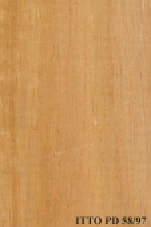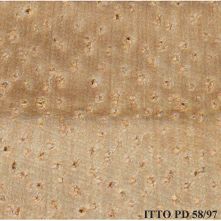
EBIARA (Berlinia grandiflora)
Trade Name
Ebiara
Scientific Name
Berlinia grandiflora Hutch. et Dalz
Family
LEGUMINOSAE
Common Names
M'possa (Zaire); M'possa (Congo); Essabem (Cameroon); M'possa (Angola); Wupa; Ubuda; Tshitemba; Sau; Rose zebrano; Obwa; Mutoke; Mubangu; Lupemba; Kpende guli; Kibibi; Gborduorh; Gbor-du-orh; Esule; Essoule; Essabem; Agyemera; Adapo; M`possa (Zaire); Berlinia (United Kingdom); Sarkpei (Sierra Leone); Ekpogoi (Nigeria); Berlinia (Germany); Ebiara (Gabon); Pocouli (Côte d`Ivoire); Melegba (Côte d`Ivoire); M`possa (Congo); Abem (Cameroon)
Scientific Name Synonyms
Westia grandiflora Vahl; Berlinia heudelotiana Baill.; Berlinia acuminata Soland ex Hook. f. in Hook.
Description Of The Tree
Botanical Description
The tree reaches a height of 32 to 43 m. The bole is often clear and fairly straight, cylindrical and free of buttresses. The trunk diameter attains 100 up to 170 cm.
Natural Habitat
Berlinia grandiflora is found in various forest types like savanna formations, marshy localities, or dense forests.
Natural Distribution
West Africa and reaching to the Democratic Republic of the Congo.
Wood Identification
Anatomic Description Of Wood
Wood diffuse porous. Occasionally vessels exclusively solitary (over 90%). Tangential diameter of vessel lumina 200 micras or more (large). Vestured pits. Vessels per mm2 less than 6 (rare). Simple perforation plates. Vessel-ray pits similar to intervessel pits Axial parenchyma in marginal or in seemingly marginal bands. Axial parenchyma thick lozenge-aliform. Axial parenchyma aliform. Occasionally axial parenchyma confluent. Prismatic crystals in chambered axial parenchyma cells and/or in fibers. 3 to 4 cells per pa Rays more than 10 per mm (abundant). Rays non-storied. Rays 1 to 2 seriate. Homogeneous rays and/or sub-homogeneous rays (all ray cells procumbent). Non-septate fibers. Fibers with simple to minutely bordered pits.
-
 Wood Macro Photo Tangential Plane
Wood Macro Photo Tangential Plane
-
 Wood Micro Photo Of Transversal Section
Wood Micro Photo Of Transversal Section
Availability
Cites Status
Unrestricted
General Wood Description
Color
The sapwood is whitish to pinkish, it has a thickness of 10 to 15 cm. The heartwood is pink brown to dark red brown with dark brown or purple streaks, it is clearly demarcated.
COLOR INDEX (1=Black, 7=Light yellow,white)
5
Grain
Straight or slightly interlocked, sometimes with an influence on further processing operations.
Texture
The texture varies from medium to coarse.
Natural Durability
Moderately durable to decay. Without preservative treatment, this species can be used only under risk of occasional re-humidification. It is not suited for uses with risks of permanent or long-lasting humidification. Moderately resistant to termites attack
Natural durability index (1= Very high durability, 7=Vey low durability)
3
Internal Growth Stresses
No residual growth stresses are found.
Resistance To Impregnation
Difficult to treat with only a low penetration of the preservative products.
Wood Physical Properties
Basic Density or Specific Gravity (O.D. weight/vol. green) (g/cm³)
0.66
Air-dry Density (Weight and volume at 12%MC) (g/cm³)
0.74
Recommended Dry Kiln Schedule
FR-6
Wood Chemical Properties
Wood Mechanical Properties
Bending Strength (MOR),12%MC (kgf/cm²)
921
Compression parallel to fiber 12%MC (kgf/cm²)
609
Compression perpendicular to fiber 12%MC (kgf/cm²)
81
Janka hardness (side) 12%MC (kgf)
681
Janka hardness (end grain) 12%MC (kgf)
771
Workability
Sawing
It is easy to saw.
Rotary Veneer Cutting
Suitable for slicing, also suitable for peeling if treated.
Sliced Veneer
Suitable for slicing, also suitable for peeling if treated.
Blunting Effect
Slight blunting effect; ordinary tools can be used for sawing and machining.
Machining
Machining of this species is reportedly easy.
Planing
Moderately easy; tools must be cautiously sharpened.
Moulding
Moderately easy; tools must be cautiously sharpened.
Turning
30
Boring
Moderately easy; tools must be cautiously sharpened.
Mortising
Moderately easy; tools must be cautiously sharpened.
Nailing
Pre-boring is necessary.
Gluing
Glues well if basic gluing technical rules are followed.
Sanding
Easy to perform; it gives good results.
Polishing
Needs pre-coating.
Steam Bending
This species can be used for steam bending.
Response To Hand Tools
No particular problems.
REFERENCED USES
End Uses Summary
HOUSING GENERAL, beams, joists, boards, flooring, parquet, frames, steps, panelling, fittings, shutter boards, FURNITURE AND CABINETS, luxury furniture, cabinets, PLYWOOD AND VENEER, faces, Decorative veneer, TURNING, ornaments, turned furniture, cutlery, lasts, OTHER AND MUSICAL INSTRUMENTS, handicrafts
General Housing
- 10 - Silica in Timbers
Beams
- 11 - Prospect: The wood database
Joists
- 12 - Tropical timbers of the world. Part I-Tropical American Species
Boards
- 13 - Dry kiln schedules for commercial woods. Temperate and tropical. Section III. Latin American (Mexico, Central, and South America) Woods–Conventional Temperatures
Flooring
- 14 - Handbook of Hardwoods
Parquet
- 15 - Empire Timbers
Frames
- 16 - Woods of the World
Steps
- 17 - Tree Conservation Database
Paneling
- 18 - W3TROPICOS Missouri Botanical Garden
Fittings
- 19 - Silica in Timbers
Shutter Boards
- 20 - Prospect: The wood database
Furniture Cabinets
- 21 - Tropical timbers of the world. Part III-Southeast Asian and Oceanian Species.
Furniture, Luxury
- 22 - Dry kiln schedules for commercial woods. Temperate and tropical. Section IV-Asian and Oceanian Woods
Cabinet
- 24 - Empire Timbers
Panels, Veneers
- 25 - Directory of Timber Trade Malaysia
Faces
- 26 - Annual Review and Assessment of the World Timber Situation 1998-ITTO
Decorative veneer
- 28 - Ministry of Agriculture, Fisheries & Forest of Fiji
Turning
- 30 - Embassy of Honduras in Japan
Ornaments
- 31 - Embassy of Colombia in Japan
Turned Articles
- 32 - Embassy of Cote d`Ivoire in Japan
Knife Handles
- 33 - Embassy of Gabon in Japan
Lasts
- 34 - Embassy of Indonesia in Japan
Handcraft
- 66 - Maderas latinoamericanas. VII. Caracteristicas anatomicas. propiedades fisicomecanicas, de secado, y tratabilidad de la madera juvenil de Cordia alliodora (Ruiz & Pav. Oken.)
Please Provide Information To View Producer Information